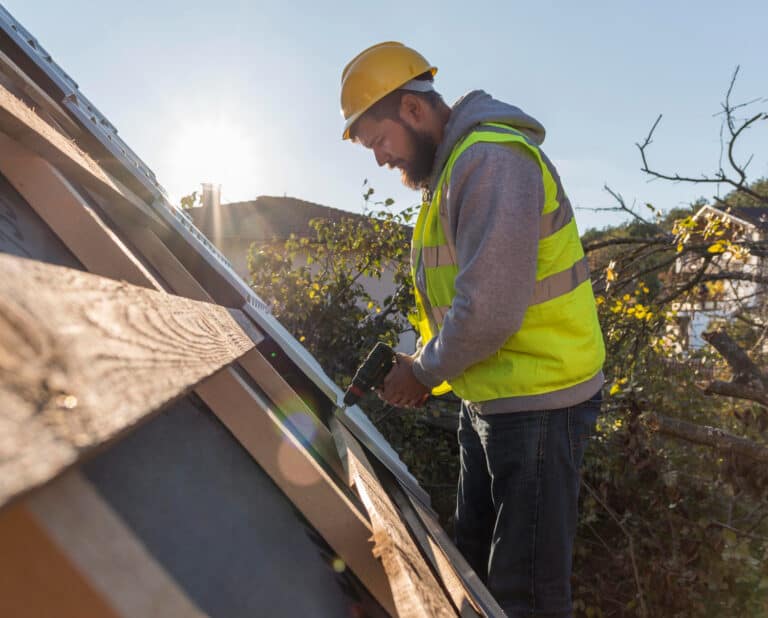Solar energy has become an increasingly popular source of renewable energy in recent years. With the rise of climate change and the need for sustainable energy, many homeowners and businesses are turning to solar roofing solutions to harness energy from above. Solar roofing solutions are designed to not only provide protection from the elements but also to generate electricity from the sun’s rays.

One of the main benefits of solar roofing solutions is their ability to reduce energy costs. By harnessing energy from the sun, homeowners and businesses can significantly reduce their reliance on traditional energy sources and save money on their energy bills. Additionally, solar roofing solutions can increase property value and provide a more sustainable and eco-friendly option for energy production.
There are a variety of solar roofing solutions available on the market, including solar tiles, solar shingles, and solar panels. Each option offers unique benefits and can be customized to fit the specific needs of the homeowner or business. With the continued advancement of solar technology, solar roofing solutions are becoming more efficient and affordable, making them an attractive option for those looking to invest in sustainable energy solutions.
Fundamentals of Solar Roofing

Benefits of Solar Roofing
Solar roofing offers a range of benefits, both for homeowners and the environment. One of the most significant advantages of solar roofing is that it can help to reduce energy bills significantly. By harnessing the power of the sun, homeowners can generate their electricity, reducing their reliance on the grid and lowering their energy bills.
In addition to cost savings, solar roofing is also an environmentally friendly solution. It produces clean, renewable energy, which helps to reduce carbon emissions and protect the planet. Solar roofing can also increase the value of a property, making it an attractive option for homeowners who are looking to invest in their homes.
Components and Materials
Solar roofing systems are made up of several components, including solar panels, racking systems, and inverters. Solar panels are typically made of silicon, which is an excellent conductor of electricity. Racking systems are used to secure the solar panels to the roof, while inverters convert the direct current (DC) produced by the panels into alternating current (AC) that can be used to power homes.
When it comes to materials, solar roofing systems can be installed on a range of roof types, including asphalt shingle, metal, and tile roofs. The type of roof will determine the type of racking system that is used to secure the solar panels.
Types of Solar Roofing Systems
There are several types of solar roofing systems available, including integrated solar roofing and solar shingles. Integrated solar roofing involves installing solar panels directly onto the roof, while solar shingles are designed to look like traditional roofing shingles but are made of photovoltaic cells.
Another type of solar roofing system is the solar tile, which is designed to look like traditional roofing tiles but is made of photovoltaic cells. Solar tiles are an excellent option for homeowners who want to maintain the aesthetic appeal of their homes while still enjoying the benefits of solar roofing.
Overall, solar roofing is an excellent solution for homeowners who want to reduce their energy bills, protect the environment, and increase the value of their homes. With a range of components and materials available, solar roofing can be customized to meet the needs of any homeowner.
Implementation and Considerations

Assessing Roof Suitability
Before installing a solar roofing system, it is important to assess the suitability of the roof. The roof should be structurally sound and able to support the weight of the solar panels. The orientation and angle of the roof should also be considered to ensure maximum exposure to sunlight. A professional installer can help assess the roof’s suitability and recommend the best solar roofing solution.
Installation Process
The installation process for solar roofing solutions typically involves the following steps:
- Preparing the roof: The roof is cleaned and any necessary repairs are made.
- Installing the mounting system: The mounting system is installed on the roof and secured to the rafters.
- Installing the solar panels: The solar panels are installed on the mounting system and wired together.
- Connecting to the electrical system: The solar panels are connected to the electrical system of the building.
A professional installer can ensure that the installation process is done correctly and safely.
Maintenance and Durability
Solar roofing solutions require minimal maintenance. The solar panels should be cleaned periodically to remove any dirt or debris that may reduce their efficiency. The mounting system should also be inspected regularly to ensure that it is secure and functioning properly.
Most solar roofing solutions are designed to be durable and long-lasting. They are typically made from materials that can withstand harsh weather conditions and are resistant to corrosion and damage.
Cost Analysis and Incentives
The cost of installing a solar roofing system can vary depending on the size of the system and the complexity of the installation. However, the long-term savings on energy bills can make it a worthwhile investment.
There are also various incentives available for installing solar roofing solutions. These may include tax credits, rebates, and other financial incentives offered by federal, state, and local governments.
Overall, implementing a solar roofing solution can be a cost-effective and environmentally-friendly way to harness energy from above. By assessing roof suitability, following proper installation procedures, and maintaining the system, building owners can enjoy the benefits of renewable energy for years to come.






